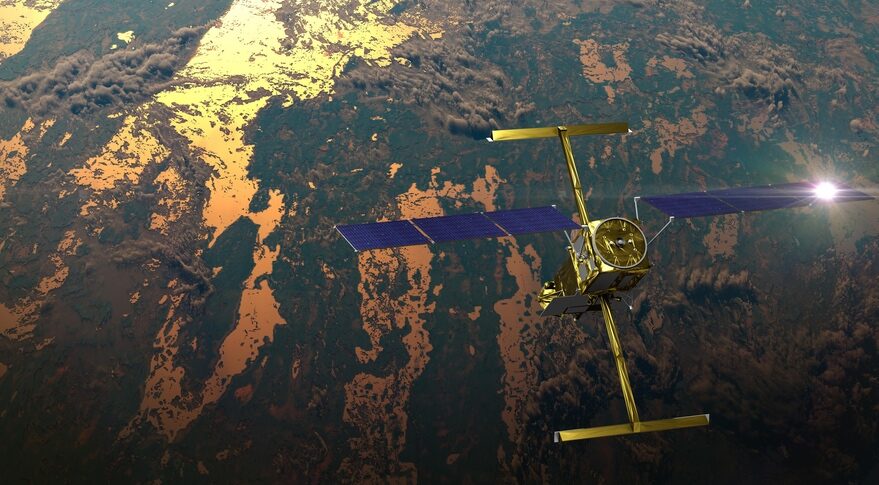
Falcon 9 launches ocean science mission for NASA and CNES (Image Credit: Space News)
WASHINGTON — A Falcon 9 successfully launched an Earth science mission jointly developed by the United States and France to monitor water levels and the effects of climate change.
The Falcon 9 lifted off from Space Launch Complex 4E at Vandenberg Space Force Base in California at 6:46 a.m. Eastern Dec. 16. The rocket’s upper stage released the payload, the Surface Water and Ocean Topography (SWOT) spacecraft, into an 890-kilometer orbit 52 minutes later. The rocket’s first stage, making its sixth flight, landed back at the launch site seven and a half minutes after liftoff.
The launch was previously scheduled for Dec. 15 but SpaceX postponed it to perform inspections of two first-stage engines where moisture was noticed. That moisture could have been water left over from recent rains, leaking fuel or a fluid used in the engine refurbishment process between flights, said Julianna Scheiman, civil satellite missions director at SpaceX, during a Dec. 14 pre-launch briefing.
If it was water, the launch could proceed, but if not the engines would need to be replaced, a process that would have delayed the launch by “many days,” she said. NASA said late Dec. 15 that inspections had cleared the launch without requiring an engine replacement.
SWOT is a joint mission of NASA and the French space agency CNES to track water levels globally with much better resolution than past spacecraft. “What SWOT will do is give us a ten-fold improvement in the fidelity, the spatial resolution of our measurements of water height,” said Karen St. Germain, director of NASA’s Earth science division, at the pre-launch briefing.
That improved resolution will provide new data on ocean circulation and better track changes along coastlines, she said. It will also be able to measure inland water bodies like lakes and rivers that could not be tracked by earlier altimetry missions. “Globally, we’ll be able to go from seeing a couple thousand inland water bodies, like reservoirs, to millions.”
Those measurements, she said, are critical for understanding climate change effects, such as rising sea levels. “The measurements from SWOT will help us really understand how this water cycle is changing and the critical role the oceans play in climate change.”
The key instrument for SWOT is the Ka-band Radar Interferometer (KaRIn), which enables the higher resolution water height measurements. KaRIn is installed on a boom 10 meters long that will be deployed starting about four days after launch.
“It’s a first-of-its-kind design,” said Parag Vaze, SWOT project manager at NASA’s Jet Propulsion Laboratory, of KaRIn at the pre-launch briefing. “We plan to do it step-by-step, carefully.” That deployment will take about four days, completing the initial phase of post-launch commissioning of the spacecraft.
In addition to KaRIn, SWOT carries an altimeter similar to those used on the Jason series of ocean science satellites and a microwave radiometer based on the design flown on Jason-3. Three other instruments are used to precisely determine the orbit of SWOT to enable its science.
NASA spent $822.4 million on SWOT, including KaRIn and some other instruments and the launch. CNES spent 340 million euros ($362 million) on the mission, providing the altimeter and other instruments and the spacecraft bus, built by Thales Alenia Space. CNES will also handle spacecraft operations. The Canadian Space Agency and United Kingdom Space Agency also contributed components of SWOT, valued at about $26 million combined.
SWOT has a prime mission of three years, but those involved in the mission expect it to last longer. The satellite bus has a rated lifetime of at least 10 years, said Thierry Lafon, SWOT project manager at CNES. “If everything is OK on board, certainly there will be an extension of the mission. Five years is completely reachable,” he said. “I can guarantee we will be able to make this a long mission because we need this data for a long time.”
The launch is the first of two Falcon 9 missions planned by SpaceX for the day. Another Falcon 9 is scheduled to lift off from Space Launch Complex 40 at Cape Canaveral at 4:21 p.m. Eastern carrying the first two O3b mPOWER communications satellites for operator SES.
SpaceX had scheduled a third launch from Kennedy Space Center’s Launch Complex 39A carrying Starlink satellites at little as 20 minutes after the SES launch, but the company said late Dec. 15 it was “prioritizing” the O3b mPOWER launch and delayed the Starlink launch one day.








